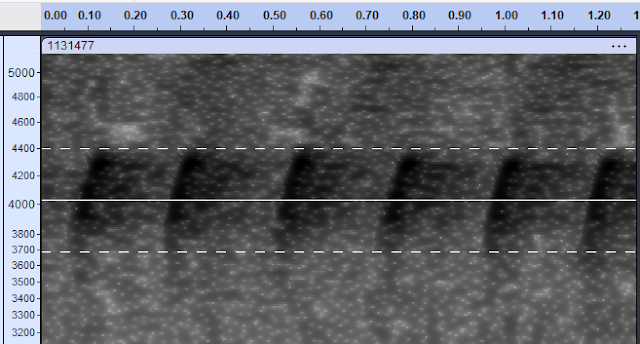 |
| Colostethus pratti from Colombia Photograph by Wilmar Agudelo Sánchez used under Creative Commons license granted in this iNaturalist record |
Pratt's Poison Frog (Colostethus pratti) is another tiny striped dart frog from the neotropics. These small frogs in the genera Colostethus and Silverstonia are very similar looking and often live in the same forest habitats, hopping around in the leaf litter. They can be told apart carefully by their patterns of light striping on their dark sides, and of course, their calls.
This species is named after the Victorian British naturalist Antwerp Edgar Pratt.
Like many dart frogs, this species transports the tadpoles from the site of egg deposition (usually a water holding pool in a plant/epiphyte) to a nearby stream or puddle after that hatch.
This species appears to be almost endemic to Panama, although there are records from northwestern Colombia.
 |
| range map from iNaturalist.org |
The identification of this frog call took some work. I originally posted it on iNaturalist as "frogs and toads" since I wasn't sure what it was. What you hear in my recording is several frogs calling back and forth, making a 8-10 rapid "whistled peeps" then resting for a second before calling again. There are two frogs calling back and forth.
I flagged iNat user (and neotropical frog call expert) ibanezr asking for help with the ID. He suggested Colostethus pratti. This sent me down the rabbit hole of reading everything I could dig up about the calls of various Colostethus species. Unfortunately the literature on this is tricky.
The call of C. panamensis call is described by Wells (1980) as "a whistled trill" of 2-5 notes with each note approximately 60ms long. There are approximately 25 ms between calls. I hear the call more as a series of "peeps" than a whistled trill, so I will use that terminology. What isn't clear from Well's description is that the call of C. panamensis apparently comes in repeated "clusters" of 3-5 notes, followed by a gap, then another 3-5 notes. That's not what is happening in my recording. My recording is 8-10 notes in each cluster.
For comparison, listen to this recording of C. panamensis (identified by R. Ibanez) from iNaturalist. This recording is notably higher in pitch (4.0 to 4.7 kHz with peak around 4.4 kHz) than mine, but has the peeps in groups of five.
Here is someone else's recording identified as C. pratti from iNaturalist. This recording shows a series of peeps with a dominant frequency around 3.8-3.9 Khz and with a series of 8-12 peeps per call.
The reported frequency range for each note in C. panamensis was from 3.2 and 4.5 kHz.
Colostethus pratti, on the other hand, is reported to produce around 19 pulses per second with a dominant frequency of 4.7 kHz.
Looking at the spectrogram for my recording, we can see my frog produced between 4 and 5 calls per second (actually 4.7) and the calls start off around 3.7 kHz and go up to 4.4 kHz. But the calls in my recording are not clustered in groups of 3-5.
Although my frogs calls were longer (more peeps than reported by Wells), this seems a much better match for Colostethus panamensis than C. pratti based on the "peep rate" and the frequency of the peeps. C. pratti would be much faster and higher.
You can hear a C. pratti call on the AmphibiaWeb account for the species. That recording has a series of rapidly repeating notes (i.e. more in the 19 notes per second range). But the recording on iNaturalist record sounds more similar to mine with a similar call structure but at a peep rate of 8 notes per second.
So whether mine is just a bit slower because it may have been cooler or some other mysterious reason, I guess the most parsimonious identification is Colostethus pratti?
Here is the my recording of the calls in question again from Anton Valley, Panama -
___________________
© Chris Harrison 2024
Ibáñez, R.I., Griffith, E.J., Lips, K.R. & Crawford, A.J. 2017. Altitudinal distribution and advertisement call of Colostethus latinasus (Amphibia: Dendrobatidae), endemic species from eastern Panama and type species of Colostethus , with a molecular assessment of similar sympatric species. Zootaxa 4254(1): 91–101. DOI: 10.11646/zootaxa.4254.1.5
iNaturalist. https://www.inaturalist.org/. Accessed August 18, 2024
Jiménez-Bolaño, J. D., A. C. Montes-Correa, F. Leonhardt, and J. M. Renjifo. 2020. Advertisement call of Pratt’s rocket frog, Colostethus pratti, from the western Andes of Colombia (Anura: Dendrobatidae). Salamandra 56: 395–400.
Wells, K.D. Behavoral ecology and social organization of a dendrobatid frog (Colostethus inguinalis).
Behav Ecol Sociobiol 6, 199–209 (1980). https://doi.org/10.1007/BF00569201

No comments:
Post a Comment